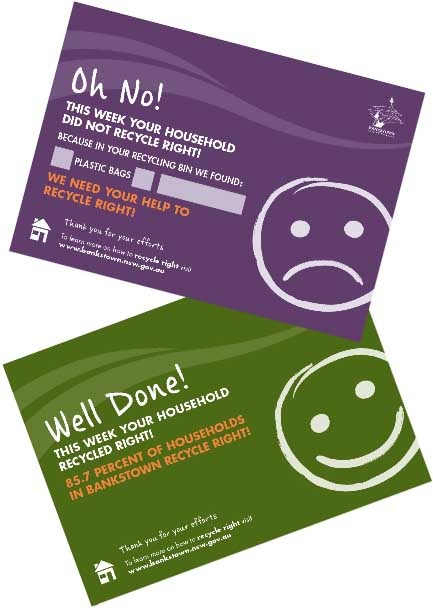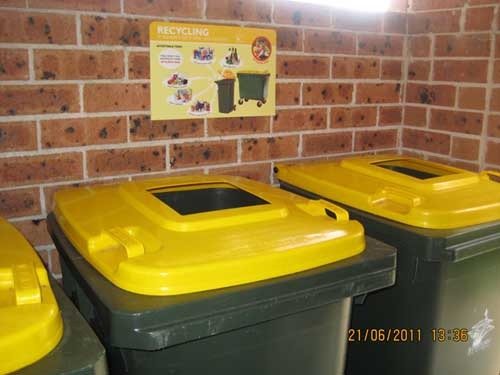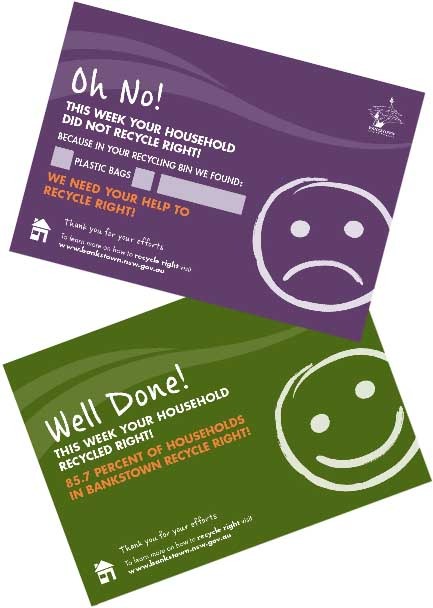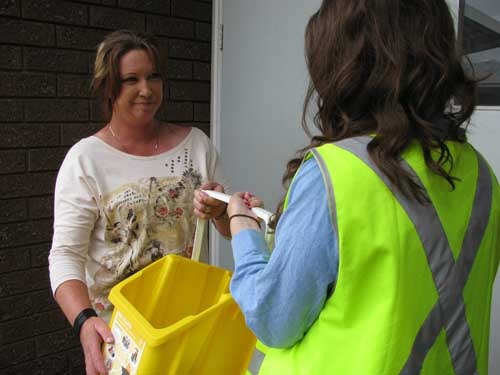Can we all be scientists? The scientific method is freely available to everyone. The most powerful invention in human history is not inherently complicated: it just means making hunches and testing them.
Daniela Santucci leads the resource recovery team at Bankstown City Council. She decided to stop despairing about the high number of plastic bags contaminating recycling in apartment blocks. Instead, working with waste educator Margaux Park, she made some informed hunches and tested them.
Inspired by Goldstein, Martin and Cialdini’s Yes!: 50 Scientifically Proven Ways to Be Persuasive, they decided to systematically test some proven social persuasion techniques.
And they added two techniques of their own… kitchen tubs and holely lids (see photos). These are not persuasion techniques – they are changes to people’s technological environment. Tubs mean that people don’t need to use plastic bags to transport recycling from kitchen to bin. Holely lids, meanwhile, make it hard to drop a full plastic bag in the bin – Daniela said she got the idea from public place bins and had been thinking about using it for years.
The basic technique they decided to test was the ‘smiley face’ feedback technique pioneered by Robert Cialdini. You can read about how this method has making a splash in the US power industry through the work of OPOWER, where Cialdini is a consultant.
Daniela and Margaux used two cards, one with a smiley face and one with a frowning face, to push householders’ psychological buttons (about fear of social condemnation for breaking social norms).
The smiley card said:
“Well Done! This week your household recycled right. 85.7% of households in Bankstown recycled right. Thank you for your efforts.”
The frowning card said:
“Oh no! This week your household did not recycle right! Because in your recycling bin we found Plastic Bags or [other]. We need your help to recycle right! Thank you for your efforts.”
(I wonder why didn’t they use the 85.7% figure here. It’s where it would have been most effective.)
Daniela and Margaux’s science experiment combined ‘smiley face/frowny face’ feedback cards with 5 other techniques:
Here are the results from apartments (“multi-unit dwellings”) for the 14 week trial:
Feedback cards alone = 0–6% reduction in contamination
Feedback cards + bulk recycling bin = 37% increase (woops!)
Feedback cards + recycling tubs (to reduce the use of plastic bags to transport recyclables from kitchen to bin) = 16% reduction
Feedback cards + a hole in the bin lid (to make dumping whole plastic bags in the recycling bin inconvenient) = 25% reduction
Feedback cards + face-to-face pledges with council staff = 25% reduction
Feedback cards + door knocking by council staff beforehand = 30% reduction
Which one is the winner? The holely bin lid is the clear winner. The hole not only reduced contamination from 30% to 5% but it was only one of these methods that can be sustained at no ongoing cost to council. It’s powerful because it’s a permanent change to the systems people use. I like that. Even though the kitchen recycling tubs only achieved a 16% reduction, they also deserve to be continued, for the same reason.
Keep in mind that the figures are probably distorted because all the households knew their waste was being audited. That would have put them on their best behaviour. In future iterations the gains will be less, but even a few percent improvement is respectable in this field.
Why does the holely bin work so well? Presumably because bins are perceived to be dirty and people prefer not to open them if they can avoid it. The hole gives people a way to insert their recyclables without touching the bin. However using the hole also forces residents to remove their bottles from the plastic bag. Hey presto, fewer plastic bags in the recycling!
You can download their full report from the EfS portal.
Here’s the holey bin:
And here’s the kitchen tub:




